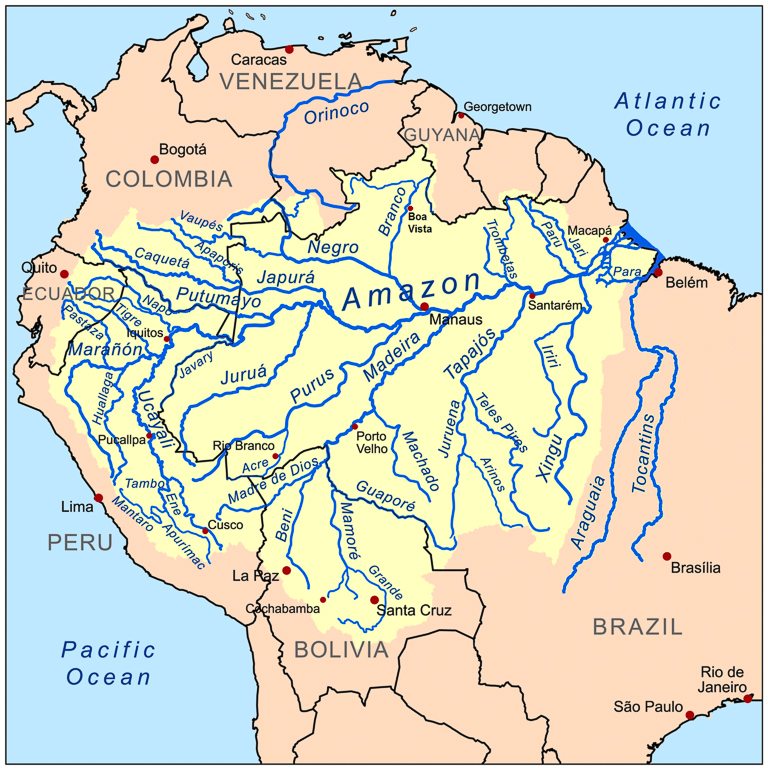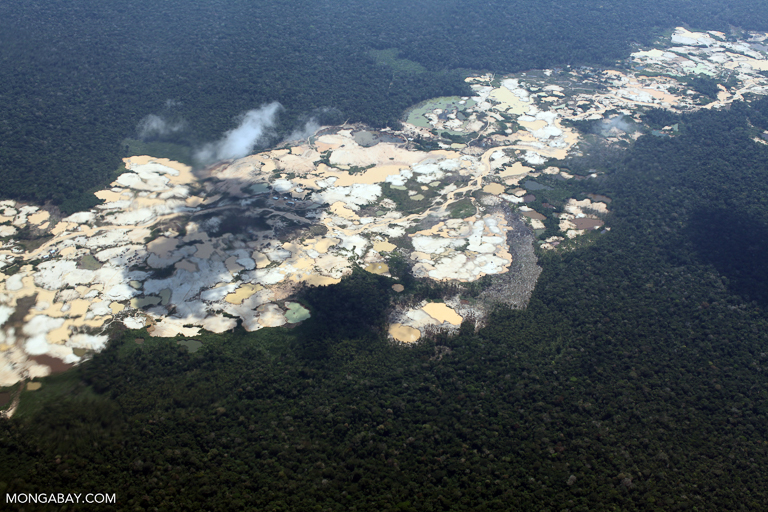- A new report from the World Resources Institute and the Amazon Geo-Referenced Socio-Environmental Information Network reveals that mining has impacted more than 20% of the Amazon’s Indigenous territory.
- The analysis shows that deforestation rates are as much as three times higher on Indigenous lands with mining compared to those without.
- The study’s authors suggest that improved law enforcement, greater investment in Indigenous communities and stricter environmental protections are necessary to combat the surge of mining in the Amazon.
Mining, both legal and illegal, impinges on more than one-fifth of Indigenous territory in the Amazon, according to a new study from the World Resources Institute (WRI) and the Amazon Geo-Referenced Socio-Environmental Information Network (RAISG).
Other research has shown that mining for gold and other minerals can wreak havoc on the local ecosystems on which these communities depend, increasing deforestation rates and sullying rivers. And the search for minerals often drags problems like drug use, alcoholism and prostitution into communities and creates destructive social conflict.
Mining’s reach has extended over 1,131 distinct territories across 450,000 square kilometers (174,000 square miles) of the six Amazonian countries included in the study — Bolivia, Brazil, Colombia, Ecuador, Guyana and Peru — write the study’s authors. The analysis reveals that forests disappear up to three times faster in places with mining than in places without it, and the often toxic chemicals used by miners, including mercury, have touched 30 or more rivers in the world’s largest rainforest.

Michael McGarrell, the human rights coordinator for COICA and a representative of the Amerindian People’s Association in Guyana, who was not involved in the study, said the industry’s ubiquity isn’t news to Indigenous leaders. COICA is an organization that represents Indigenous groups in the Amazon.
“The new WRI research confirms what Indigenous leaders have been reporting to COICA from across the Amazon. Under cover of the COVID-19 pandemic, it has only gotten worse,” McGarrell told reporters in a Zoom call. “We’re under siege from legal and illegal mining, and our governments are doing little to help us protect and enforce the rights that do exist.”
The countries that the authors studied all have laws that at least notionally recognize Indigenous people’s rights to the land. In Brazil, all mining on Indigenous land is outlawed by the country’s constitution, though Jair Bolsonaro, Brazil’s president, introduced a bill in Congress this year to change that provision. These six countries are also parties to international agreements on these rights. All have signed the United Nations Declaration on the Rights of Indigenous Peoples, and all but Guyana have signed the International Labour Organization’s Indigenous and Tribal Peoples Convention.
But protecting Indigenous communities in the face of this onslaught of mining will require greater enforcement and broader participation from all sectors of society, Peter Veit, director of the Land and Resource Rights Initiative at WRI and one of the study’s authors, said on the call.
“Safeguarding Indigenous territories — including the sustainable development and environmental benefits they generate — will require stronger commitments and urgent actions from governments, companies, civil society leaders, nongovernmental organizations and others,” Veit said. “The new report details what these commitments and actions look like for all key actors so that Indigenous peoples can safely protect their lands and livelihoods.”

At the same time, services are lacking for Indigenous groups across the Amazon, said Eleodoro Mayorga Alba, the former minister of mines in Peru, on the press call.
“Indigenous peoples, for a long time now, do not benefit equally with regard to public services, education, water, electricity, health care, when compared to the other peoples and populations,” he said.
The study involved legal analysis looking at how laws translated into practices, a geographic information system (GIS) survey to determine the locations and extent of mining activities across the Amazon, and six case studies involving interviews and scientific literature reviews.
“Our research was designed to better understand and actually put some numbers behind the implications of this expansion for indigenous people,” Veit said.
Research by WRI and other scientists has shown that Indigenous communities are stalwart protectors of the forest, even as they depend on it for food, water, shelter and medicine.
“We now know that when our rights are strong, deforestation rates on our lands are two or three times lower than in forest managed by others,” McGarrell said. “This means we are the climate solution.”
But mining on Indigenous land erases much of that advantage. The researchers found that forest loss was three times higher on Indigenous lands with mining in Bolivia, Ecuador and Peru, and as much as two times higher in Colombia and Venezuela.
McGarrell said that, in some cases, Indigenous people themselves participate in the mining.
“Some Indigenous miners as well have decided, if people are going to come take away … our resources, why shouldn’t we get some of it as well?” he said. “We will get involved in mining because we also need money to pay for school things for our kids. We need to get food into our houses.”

More significant investment in these communities could make mining less attractive, said Patricia Quijano Vallejos, the lead author and a research analyst with WRI.
“They need to increase the capacity to access to their lands,” she said, “and they need tools for development — for example, the ability to monitor their lands — so that they can continue their struggle against illegal mining.”
The report also notes the need for well-resourced law enforcement in these territories and for strict environmental and social standards. McGarrell said that, in Guyana, impact assessments should be part of the process of deciding where mining concessions are sited, not just before exploitation.
“We have a system where mining concessions are granted willy-nilly without any proper environmental impact assessments,” he said. “This must stop. Responsibility starts in the allocation process as well.”
McGarrell said that Indigenous peoples could be valuable partners in protecting forests and the carbon they contain while also mining responsibly.
“WRI scientists call Indigenous peoples and rural communities the world’s secret weapon for preserving forests,” he said. “Rather than framing Indigenous peoples as poor and primitive, we invite political and economic actors to partner with our peoples. We invite you to strengthen what science suggests we have to offer a way of life that envisions humanity as one with the natural world.”
Banner image of Rio Huaypetue gold mine in Peru by Rhett A. Butler/Mongabay.
John Cannon is a staff features writer with Mongabay. Find him on Twitter: @johnccannon
FEEDBACK: Use this form to send a message to the author of this post. If you want to post a public comment, you can do that at the bottom of the page.
